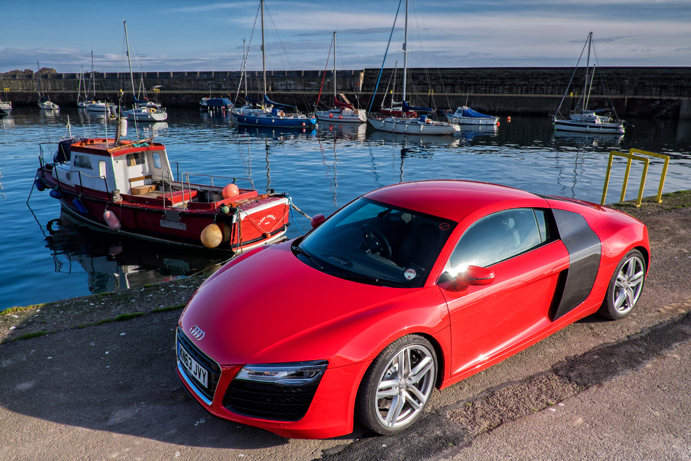

Audi and Le Mans is a combination that go together like strawberries and cream or Fred Astaire and Ginger Rogers. Since 2000 the German manufacturer has won the greatest race in the world no less than twelve times, only missing out on the top step of the podium in 2003 (Bentley) and 2009 (Peugeot) and winning the FIA World Endurance Manufacturers Championship in 2012 and 2013; an impressive record of achievement.
Since 1923 the 24 Hours of Le Mans has been the testing ground for manufacturers to develop and fine tune new technology that has then been used on road cars. Audi’s successful involvement in endurance racing has resulted in many of the systems used on the race cars being adapted and developed for use on their road cars, especially on the German manufacturer’s flagship sportscar, the R8.

The 4.2 litre V8 FSI engine and 5.2 litre V10 FSI engines used in the R8 can trace its ancestry back to its namesake that won the 24 Hours of Le Mans in 2001 and went on to further wins in 2002, 2004 and 2005 before Audi switched to diesel power. That car was powered by a 3.6 litre V8 but the basis of the technology used to win at Le Mans is now used across the Volkswagen Audi Group (VAG) car ranges. FSI stands for Fuel-Stratified Injection, which is a variation on the concept of petrol direct injection developed to maximize both power and fuel economy at the same time.
Another example of the crossover between road cars and race cars is the Audi Space Frame (ASF), which is the backbone of both the production and race car models. The aluminum frame weighs only 210 kilograms and is therefore about 40 per cent less than a comparable steel construction.

So what is the Audi R8 like to drive on the open road? The version we had to test was the Audi R8 4.2 FSI V8 Quattro 2dr S Tronic. The V8 is the ‘baby’ of the R8 family but don’t think for one minute that this is in any way a lesser car. This is a 430 bhp super car that will propel you to 60mph from a standing start in 4.6 seconds and hit a top speed of 188mph.
On the other hand this is not a stripped out racing car for the road, the Audi R8 4.2 FSI V8 Quattro is the consummate Grand Tourer, with all the luxury that a top Audi can provide and the drama of a sportscar when you want it.
The quattro badge heralds another motorsport development link, but this time from the world of rallying. First developed by Audi in the 1980s, quattro 4x4 systems have also been used on race cars and most recently on the World Endurance Championship winning cars of 2012 and 2013, the Audi R18 e-tron quattro. On the R8 the quattro system puts the power from the V8 to all four wheels, propelling the car forward with surety in any conditions.

The cabin layout is typically Audi, with reminders that you are sitting somewhere very special with R8 badges and stitched leather at every turn. The seats are extremely comfortable and long journeys would not be a problem. There is all the comforts of a big saloon here as well – Sat Nav, Climate Control, Cruise Control, In Car Entertainment System – this is certainly a class act.
Put the key into the slot and turn and the V8 engine fires into life. This is a mid engine car so the soundtrack from behind your head, even at idle, is intoxicating. Out on the open road you just want to rev the engine to hear the glorious sound it makes.
The engine itself is a work of art, so much so Audi do not hide it away, they put it under a piece of glass so it is on display to the world.

The S Tronic label refers to the seven-speed DSG transmission on the R8 and is yet another part of the car that has been developed with Audi’s racing heritage. The driver can decide between full automatic or switch to manual and select gear changes via the push/pull gear lever or the paddles behind the steering wheel. With the paddles you can dream that you are nine times Le Mans winner Tom Kristensen as you flick through the gears as you accelerate out of corner. If you decide to leave the transmission in full auto, you can select ‘SPORT’ which means the engine will rev higher before changing up and on the downshifts the throttle is ‘blipped’ to make it sound more sporty.
Around town this R8 handles the lumps and bumps of a typical British road with ease and speed humps are not the daunting obstacles that you would imagine in a sports car. In fact the R8 is very, well for want of a better description, Audi. It tackles any road conditions with consummate ease, whether it is a dual carriageway, city road or a windy B road out in the country.

On the open road you know you are driving Audi’s finest as the V8 suddenly comes to life and produces a sound that will set the hairs on the back of your neck tingling. The acceleration is extraordinary; the gear changes from the S Tronic transmission precise and the power delivery is poised as it is sent to all four wheels. But it is the soundtrack from the V8 that is the best bit, it made you want to rev the engine just to hear the noise from the power plant that was situated just a few centimetres the other side of the bulkhead by your left ear. This is a car you just want to drive, and drive, and drive.

So why does Audi, Porsche, Toyota, Aston Martin and Ferrari compete in the FIA World Endurance Championship and at Le Mans? The simple answer can be seen in cars such as the Audi R8 4.2 FSI V8 Quattro 2dr S Tronic and the Aston Martin Vantage V12 we have tested so far this year. They clearly demonstrate the development of the cars on the race track have a direct benefit to the cars we drive on the road. The R8 might be the top end of the price scale, but the whole of the Audi car range, from the A1 up to the R8, have benefitted from the technology that is used to win the ultimate test, the 24 Hours of Le Mans.

Words by Jeff Carter Images by Maclean Photographic
Images taken in and around Dunbar, Scotland